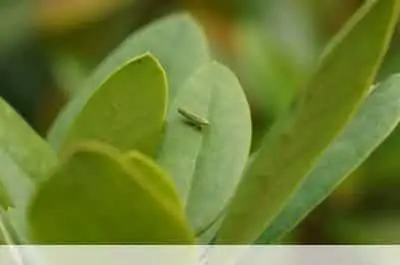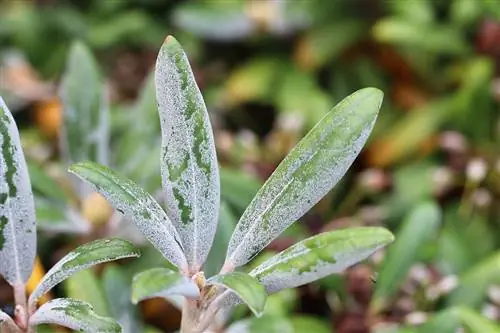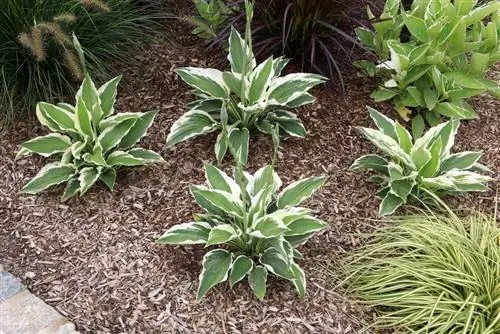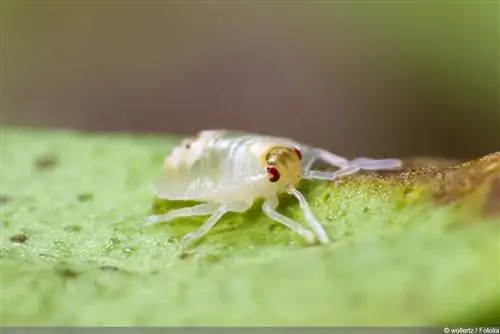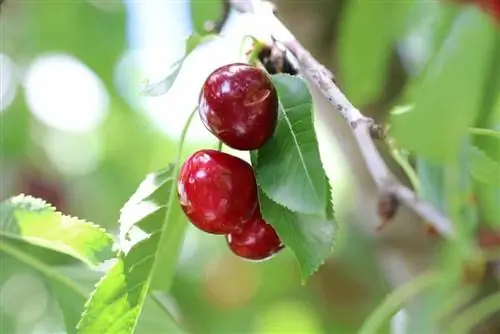- Author admin [email protected].
- Public 2023-12-17 03:39.
- Last modified 2025-06-01 06:48.
Rhododendron leafhoppers are small and pretty and suck leaves, but only very little and briefly and are not threatening to any he althy rhododendron. You only have to fight rhododendron leafhoppers if there are too many of them (due to a lack of natural enemies), not because of bud death, which can migrate into the plant through any wound. Only an ecologically he althy environment can keep both of them in check in the long term. An overview of the entire problem area follows:
Description and classification
As a cicada, the rhododendron cicada is not necessarily one of the insects that every person can classify straight away, neither in terms of external appearance nor in terms of whether they are “rather likeable” or “rather unsympathetic” insects (orinsects at all). When people talk about butterflies or dragonflies, everyone has an image in their mind and is happy. When they talk about fleas and bedbugs, everyone has an image in their mind and is usually not happy, while hardly anyone can describe a cicada. Maybe these little creatures are better known than cicadas because they are more common?
That could be true for butterflies and bugs; worldwide there are almost 160,000 known species of butterflies (+ 700 new discoveries every year) and around 40,000 known species of bugs (the “new discovery rate” of the little stinkers is not known).
But there are only 5,680 species of dragonflies in the world, and only 2,400 species of fleas; possibly some kind of celebrity status, because of beauty or potential to be annoying.
Cicadas are quite common worldwide, well over 45,000 species, but are actually rather underrepresented in Germany: around 3,700 species of butterflies and around 3. There are only 600 species of cicadas out of 1,000 species of bugs. But at least there are only 85 species of dragonflies and just 70 species of fleas.
Like the bugs, the cicadas also belong to the so-called beaked insects, an order of insects with 80,000 known species worldwide, a tenth of which live in Europe. Again, a little less than a tenth of these are cicadas, 143 species of black-headed cicadas and 475 species of round-headed cicadas.
The rhododendron cicada (botanically Graphocephala fennahi or G. coccinea) is a round-headed cicada. At 7.5 mm, it rightly belongs to the family of dwarf cicadas and, with its design, it rightly belongs to the subfamily of decorative cicadas.
Achievements of the rhododendron cicada
The rhododendron cicada - and other cicadas - are quite important to nature (significantly more beneficial than most people), on every patch of greenery. They are significantly involved in “managing” the ecology in grassland biotopes: they work as plant vacuum cleaners, and this is not as self-serving “work” as it seems on the surface:
Rhododendron leafhoppers suck a little sap from a few leaves of a plant, about a millionth of a drop. If only a few rhododendron leafhoppers are present, the plant quickly closes the micro-hole and replenishes the plant sap. There is no damage worth mentioning, not even visible damage, the “treatment by the rhododendron leafhopper” is, from the plant’s point of view, a kind of wellness application, subsection “stimulation of the immune system”.
Because that's exactly what it's all about in an ecological context, sucking also transmits small amounts of bacteria, fungi or viruses, and these are necessary so that a (young) plant can develop resistance to potential harmful agents. As with the human species, it is important that young people come into contact with “dirt” when playing, as this is the only way they can develop a powerful immune system.
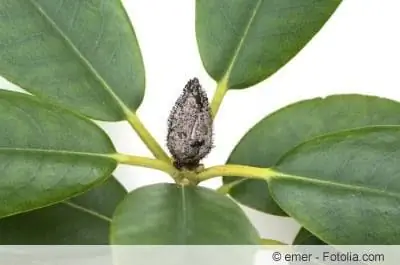
People without contact with the earth in their youth tend to develop allergies, plants without plant suckers in their youth are destroyed by almost every pest; Every ecosystem needs constant training, a training of the defenses of all those involved, so that the influences on each other balance out in a balance that enables the existence of everyone.
Rhododendron leafhoppers and perforated leaves?
Rhododendron leafhoppers are quite small, and they also make particularly small holes in the leaves.
There are around 3,000 leaf-piercing plant lice alone, and entire armies of other animals line up to gnaw, nibble, nip and sting leaf damage. Very often there is greater leaf damage than the rhododendron leafhopper causes; you usually cannot see the puncture marks of these tiny plants at all.
So you will regularly read about many possibilities for confusion when it comes to determining an infestation with rhododendron leafhoppers based solely on bite marks. Which is a rather imprecise way to put it: if you notice (=see) bite marks, it is actually more likely that another “leaf-biter” has bitten, one with a stronger set of teeth.
We'll get to the damage caused by rhododendron leafhoppers and other leaf suckers in a moment, but you don't need to get hectic, not even because of bud dying:
The rhododendron leafhopper and bud dieback
To save the honor of the rhododendron cicada, further clarification is due: The poor little harmless rhododendron cicada is fiercely fought by many home gardeners because it causes bud death. As I said, the rhododendron cicada can transfer even the smallest amounts of bacteria, fungi and viruses to the plants it pricks during its immune-boosting wellness treatment. These could certainly include bacteria, fungi and viruses that cause subsequent damage, but she hardly has Pycnostysanus mushrooms with her, the fact that she always transmits bud death is simply wrong.
And still: If you enter “rhododendron leafhopper” and “bud dieback” into the search engine, around 3,000 articles appear, all of which seem to suggest that the evil vector must be combated urgently.
It is correct that the bud death is caused by the fungus Pycnostysanus azaleae, (synonyms: Seifertia azaleae, Briosia azaleae), and it migrates into the rhododendron through injuries, also through injuries caused by the rhododendron leafhopper, as well as through injuries by aphids, torn leaves, a beetle, the storm.
You can also read very often that the rhododendron cicada does NOT directly transmit bud death - but not necessarily on the first pages of the search engine results, at the moment there are only a few websites that end up there, in addition to many platforms that are optimized in terms of ranking invest in search engine optimization AND well-researched texts (but there is hope, the trend should be towards more quality).
The true circumstances of bud fungus transmission have been known for a long time; it was scientifically researched over a decade ago: Scientists from the Julius Kühn Institute Federal Research Institute for Cultivated Plants got to the bottom of the connections in detail in a large rhododendron park in Bremen. They did not find a single rhododendron leafhopper on many rhododendrons that were severely damaged by bud dieback; rhododendrons used by the leafhoppers as “living shrubs” were often not affected by the fungus; In the evaluation, no connection could be established between infestation with rhododendron leafhoppers and the occurrence of bud rot. The scientists even found that rhododendron leafhoppers and fungi prefer different rhododendron varieties: Rhododendron leafhoppers like rhododendrons from the Pontica series and certain cultivars derived from them (most rhododendron leafhoppers populated the R. caucasicum hybrid 'Cunningham's White'), while the mushrooms R.-catawbiense hybrids and American cultivars are most severely affected.
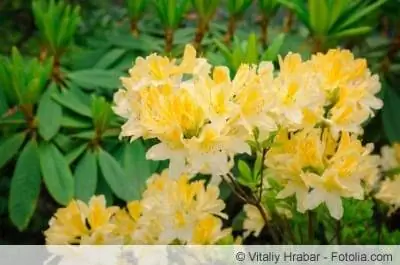
The researchers ultimately came to the conclusion that fungal and cicada infestations in the park depended on the following factors: (Too close) group planting of rhododendrons, wet soils and poor nutrient supply promote fungal infestation, while rhododendron cicadas are he althy and at the right distances, loose and airy Pricking growing rhododendrons but not harming them. Here you can read the results that the researchers published as part of the “Second International Symposium on Plant He alth in Urban Horticulture” in 2003: pub.jki.bund.de/index.php/MittBBA/article/viewFile/723/658.
It is also true that fungi and rhododendron leafhoppers can come together on the same plant, and the fungal spores are small and only need very small holes, which is why they often go unnoticed. But this thorough scientific investigation really casts serious doubt on whether the compelling connection between rhododendron leafhoppers and bud dieback is as compelling as is made out in many articles (in grateful, because so simple, accusations of ONE wrongdoer).
Also: If, as is often recommended, you break out the buds of your rhododendron after flowering (and do not dispose of them in the compost), remove the eggs of the rhododendron leafhopper and any fungus that may have migrated.
Save the rhododendron leafhopper
After the matter of transferring bud dieback has been straightened out, it's time to deal with the damage caused by the rhododendron leafhopper itself:
The adult rhododendron leafhopper lives in July and August, during this time it also sucks a little on the leaves (which the rhododendron hardly notices) and lays its eggs in the buds of the rhododendron. From September onwards, the adults slowly die, the eggs overwinter, and in May the larvae hatch and settle on the undersides of the leaves. They also feed there, but since the larvae are only 2-3 mm large and usually puncture the main leaf vein and shortly later become adult rhododendron leafhoppers, this usually doesn't matter much to the rhododendron.
If a he althy rhododendron is “visited” by a few rhododendron leafhoppers, you can just live with them and enjoy their beautiful colors (if they get close enough to the mini leafhoppers).
When rhododendron cicadas accidentally land in a garden that is not close to nature, where there are hardly any natural enemies such as chalcid wasps, lacewings, ground beetles, predatory mites, predatory bugs, parasitic wasps and spiders - and there they also encounter a large-flowered hybrid that is already weak has resistance powers and weakens even more in the less natural garden, delicate rhododendron cicadas can also achieve impressive mass reproduction.
In the short term, you can simply collect the larvae of the rhododendron leafhoppers by hand or shower them off, and any other leaf sucker should be de alt with in the same way if you are not sure whether you are really dealing with rhododendron leafhoppers. Aphids, bugs, whiteflies, etc., whatever sucks or nibbles on rhododendron leaves can first be controlled mechanically, this is still the least disruptive to nature.
Hanging up yellow panels is sometimes recommended when the female cicadas lay their eggs in the flower buds from September; However, with a view to a he althy environment full of rhododendron cicada enemies, this is not a good idea; usually more other useful small fliers land on the adhesive boards than rhododendron cicadas.
In the long term, you will only have peace of mind from rhododendron leafhoppers and all sorts of other pests in a garden that is not very close to nature if you design the garden to be more natural. With lots of hardy native plants (e.g. native Rhododendron ferrugineum and Rhododendron hirsutum), a bit of clutter (deadwood, piles, mulch) to provide shelter and overwintering opportunities for beneficial insects and other small animals. Then there will soon be enough beneficial insects in the garden, and when there is a lot of creeping and running, no single species will gain the upper hand.
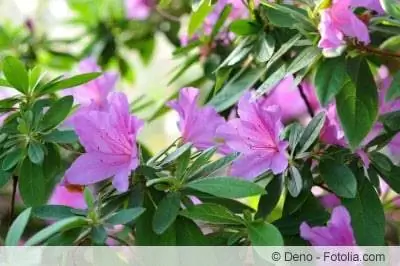
If the “arrival of the rhododendron” is still imminent, you should definitely make sure to buy a robust, he althy rhododendron. It's better not to have a particularly large-flowered, but over-bred hybrid, but rather strong, small-flowered species or varieties with very hairy leaves, as they are significantly less populated and can survive it better. You can support existing rhododendrons that have proven to be weaklings with plant strengtheners until the garden has become a little more natural again.
But the rhododendron cicadas deserve rescue (survival, propagation); the University of Graz even considers them to be the “insects of the 21st century” because their ecological role in nature is so important.
Combating bud dieback
If the cicada and mushroom do not meet in the rhododendron park, but only have one rhododendron available in a garden, they will settle on this rhododendron, even if it is not their favorite variety. Then the rhododendron cicada drills for the fungus, if it doesn't do this in full force, possibly unnoticed.
You won't notice the fungus until next spring, when many dark 1 to 2 mm long fungal hairs develop on the surface of the rhododendron's buds, you could also call it a fungal lawn.
Each “mushroom hair” ends at the tip with a micro-ball full of spores, which the fungus now wants to scatter. You should prevent it from doing this as quickly as possible by removing the buds and disposing of them away from the garden; Thorough thinning of the plant prevents further infestation.
Off to battle? Better not
Regardless of whether it is a rhododendron leafhopper or a bud dying: Please do not uncritically resort to the lethal injection, because after all the experiences with plant protection products that independent scientists have reported in recent years, nothing good will most likely come of the cheerful “off to fight”..
The end of the above section “Achievements of the rhododendron leafhopper” can be continued here: People from households exposed to disinfectants develop multiple chemical sensitivity (new environmental disease), plants in gardens exposed to pesticides develop resistance, do not live long or die straight away - the pictures are pretty similar when people want to influence biological or ecological connections that have developed over a long time using new means (largely unknown to them).
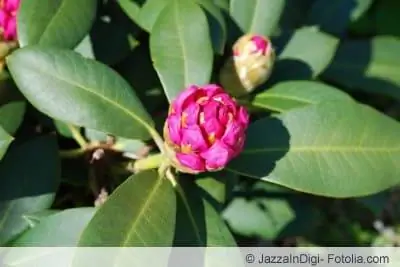
It is likely that the fight in the garden will be an eternal battle, against ever new pests that develop mass populations more and more quickly as more natural enemies have already been destroyed - but you may not be able to fight endlessly because you accidentally put themselves out of action while fighting (Parkinson's has long been recognized as an occupational disease for farmers in France, but farmers in Germany are still fighting for it).
Whether pesticides are always poison injections? Yes, always, at least if they have a name with “zid” at the end, which comes from the Latin “caedere”=to kill and is meant in exactly the same way. Acaricides kill mites and arachnids, algicides kill algae, arboricides kill woody plants, avicides kill birds, bactericides kill bacteria, fungicides kill fungi, herbicides kill plants, graminicides kill grasses, insecticides kill insects, molluscicides kill snails, nematicides kill roundworms, ovicides kill insect eggs, Rodenticides kill rodents. This is what these -cides do as “plant protection products” when they are sprayed in agriculture and in the garden to “protect” plants.
If they are supposed to “protect” people, they are used directly on people themselves or in living and common rooms and are called biocides, or e.g. E.g.:
- Disinfectants (non-critical use=allergy + environmental diseases)
- Wood preservatives (lindane, which we have used for a long time, is classified by the WHO as a “carcinogen in humans” and is discussed as a contributor to Parkinson’s disease, multiple sclerosis, etc.)
- Pesticides (cheerful poison cocktails in many compositions)
- Repellents (including mosquito spray, often with diethyltoluamide such as “Care Plus Deet Anti Insect”, which has already proven itself in the Vietnam War, the “Plus” ranges from allergies to epileptic seizures)
- Fluids for embalming (note: no -zid, the undertaker probably survives)
The regulation on the placing on the market of biocidal products recognizes a total of 22 product types (groups with products that kill any form of life), although product type 20: “Products against other vertebrates” is really something to think about, because the entire animal world is already in the remaining 21 product types are recorded. In any case, the term “biocide” generalizes it quite well: kills life, and the discussion about how much of that is human life is just beginning.
There are two approved acaricides against leafhoppers that contain the particularly exciting active ingredient fenpyroximate. Fenpyroximate is a poison that blocks mitochondrial electron transport in complex I, which is part of the respiratory chain in almost all living things and certainly in humans. Fenpyroximate is therefore “harmful to human he alth if inhaled”, it also causes “severe eye irritation”, and according to the hazardous substance labeling you should “avoid release into the environment” - please do that.
Mushrooms that cause bud death would have to be killed with fungicides, but the fungicides often do not kill the fungi, but only make them resistant. No existing fungicide works against the fungus Pycnostysanus azaleae, which is why no fungicide is approved against it, neither for use in home and allotment gardens nor for commercial users.
Conclusion
Rhododendron leafhoppers exist, as do bud dying mushrooms, and both could also be seen in your garden. They will only break out into mass reproduction if an ecological imbalance gives them the chance to do so, and this danger becomes smaller and smaller the more nature you allow in the garden.

